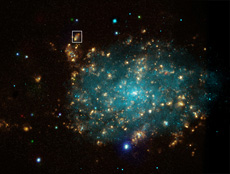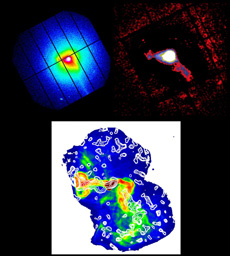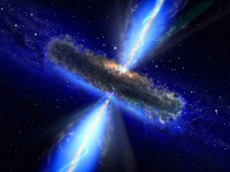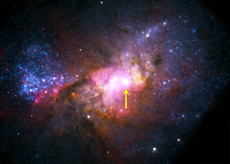Q. A basic question: what is black hole?

Inside the square is a black hole formed after a supernova explosion, which is located on the outer rim of galaxy NGC7793. (courtesy: X-ray (NASA/CXC/Univ of Strasbourg/M. Pakull et al); Optical (ESO/VLT/Univ of Strasbourg/M. Pakull et al); H-alpha (NOAO/AURA/NSF/CTIO 1.5m))

(Top Left) Virgo galaxy cluster observed by XMM-Newton. (Top Right) Image of a black hole with X-ray jets extracted from the top left photo. (Bottom) X-ray jets, indicated in white, superimposed over a radio map of the galaxy. Two lines of radio-wave jets stretching left and below overlap with X-ray jets. (courtesy: E. Belsole, Service d'Astrophysique, CEA Saclay, France)
A black hole is a celestial object that has very high density and a strong gravitational field. Even light cannot escape its gravitational field, so a black hole itself doesn’t release light. Thus, we cannot observe black holes directly. But when gases are sucked into a black hole, they reach ultra-high temperatures and release a lot of energy, flashing brightly in the X-ray spectrum. This proves the existence of a black hole. Most galaxies have a black hole at their center.
To date, two kinds of black holes have been observed. One type is generated after a supernova explosion. When a massive star with more than 30 times the mass of the Sun finishes its life, a supernova explosion occurs, and the center of the star becomes unable to withstand its own gravity, shrinking to the utmost limit to become a black hole. At this point, a black hole has a mass about 10 times greater than the Sun.
Another kind is an enormous black hole with a mass that is millions, or even several hundred million times greater than that of the Sun. It still remains a mystery how such an enormous black hole can be generated.
Q. What is your research specialty? Tell us about your major research achievement?
My major research topic is the formation of galaxies and galaxy clusters. In conjunction with that, I research black holes located at the center of galaxies. As for my major achievement to date, my research on the Virgo galaxy cluster using the European X-ray astronomy satellite XMM-Newton stands out. At the center of this galaxy cluster, there is a big galaxy known as M87, and in its center is an enormous black hole about 100 million times the mass of the Sun. We captured very high-energy gas shooting out from this black hole. A black hole has such strong gravity that it sucks in anything around it, but at the same time, it provides very high energy to areas around it.
Meanwhile, because the gas density in a galaxy cluster is extremely high, X-ray radiation releases very strong energy. Normally, when energy is released, a gas should cool down and stop emitting X-rays. But at the center of a galaxy cluster, X-ray emissions continue. Continuous X-ray emissions need a heat source, and one of the possibilities is the heavy mass of a black hole. It is thought that a huge black hole at the center of a galaxy releases energy to heat the surrounding gas. My research achieved evidence to support this theory.



